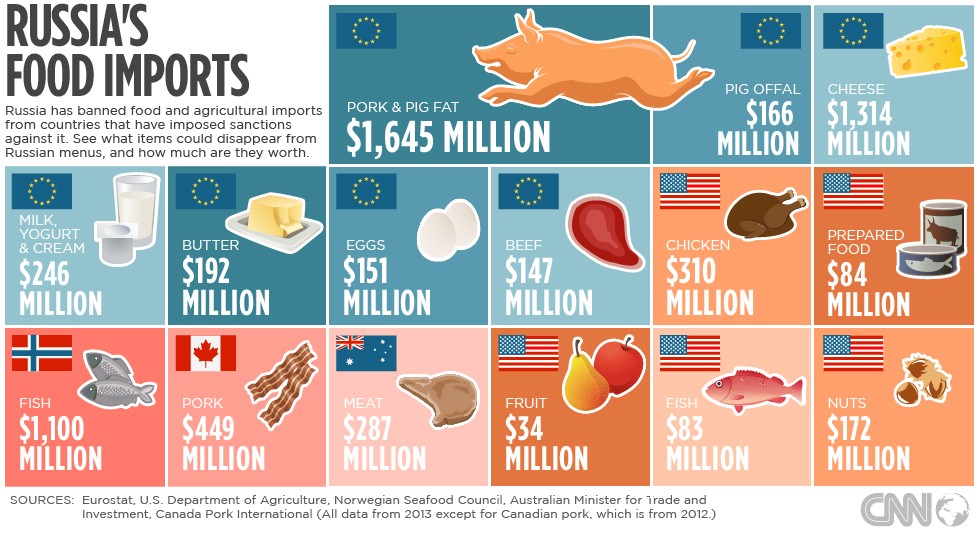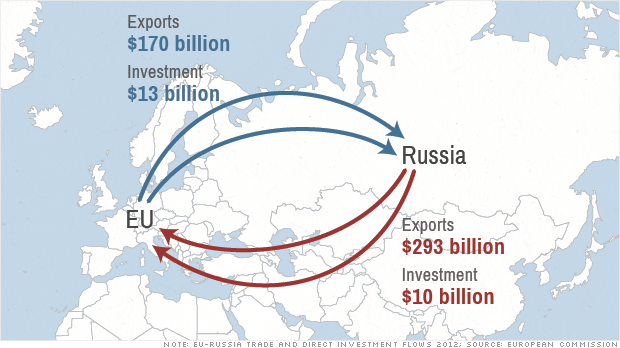How US & European Union Sanctions Impact Russia
Post on: 27 Май, 2015 No Comment

The economic sanctions imposed by the United States and European Union on Russia are having a crippling effect. The economic sanctions are focused on Russia’s key defense, energy, and financial service sectors, and include asset freezes, controls on financing, restrictions on access to capital markets, controls on dual-use items, and controls on goods and services for the Russian military. The sanctions’ impact is exacerbated by the near 50% slide in crude oil prices, as Russia is the world’s second-biggest exporter of crude oil and it relies on oil sales for almost half of its domestic budget. Severely impacted by the one-two punch of sanctions and sliding oil prices, the Russian economy shrank 0.5% in November 2014, the first contraction in five years. Here are a number of negative effects that economic sanctions (and sliding oil prices) are having on the Russian economy:
- Currency collapse. On December 16, 2014, the ruble’s value dropped 20%, trading at a record 80 rubles per U.S. dollar, after the Central Bank of Russia jacked up interest rates by 6.5 percentage points – from 10.5% to 17% – in an attempt to stop a run on the currency. The rate hike was the largest since 1998, when the Russian economy was thrown into disarray after a debt default. While the rate hike initially seemed futile, the ruble subsequently staged its biggest weekly rally in 16 years, as Russian companies scrambling to meet tax deadlines bought the currency and the Russian government mandated that exporters convert foreign exchange revenues into rubles. Nonetheless, the ruble shed 41% of its value against the dollar in 2014, the worst performance among currencies of the world’s largest economies.
- Higher interest rates. The massive and unexpected rate hike by the Russian central bank was meant to demonstrate its resolve to support the ruble. It was also meant to inflict a crushing blow on currency speculators, as it would be prohibitively expensive to maintain short positions in the ruble, while the anticipated turnaround in the ruble could potentially spark huge short-covering. Unfortunately, significantly higher interest rates also wreaked havoc on the economy, as consumers and corporations faced dramatically higher borrowing costs.
- Recession and higher inflation. While it is difficult to isolate the economic impact of sanctions from the effect of lower crude oil prices, the combination of the two may lead to recession and higher inflation. On December 15, the Russian central bank said that in a scenario where crude oil averages $60 per barrel in 2015, the economy could contract as much as 4.7%. Inflation, already at a three-year high, is forecast to top 10% by the end of 2015.
- Capital outflows. Foreign investors tend to flee when there is a toxic combination of a plunging currency, a deep recession, and higher inflation, which is the situation that Russia now faces. Net capital outflows could exceed $130 billion in 2014, more than double the total for 2013.
- Foreign exchange reserves depletion. As a result of intervention in currency markets to support the ruble and capital outflows, Russia’s forex reserves fell by $80 billion in 2014 to $416 billion at the beginning of December. But while Russia has the world’s fourth-largest forex reserves, external debt owed by Russian banks, companies, and state bodies totals nearly $700 billion. As most of this debt is in dollars, the ruble’s plunge against the greenback has increased the cost of servicing such debt substantially. The country’s central bank has earmarked an additional $85 billion for currency operations in 2015 if Russia is faced with an economic crisis triggered by crude oil at $60 a barrel. Rapid depletion of currency reserves may make it difficult to continue supporting the ruble and service debt.
- Reduced consumer spending. Consumer spending led the Russian recovery after the 2008-09 recession, but it may plunge as much as 6.5% in 2015, according to the Russian central bank. This is largely because Russian consumers are currently investing heavily in durable goods such as cars and appliances (as stores of value) because of the run on the ruble. As a result, consumer demand for these goods may dry up in 2015.
- Stock market crash. The Russian Trading System (RTS$) index dropped 45% fin 2014, the worst performance of any major equity index. A crash of this magnitude signals that more problems lie ahead for the Russian economy.
- Potential credit rating downgrade. On December 23, Standard & Poor’s said that, as a result of the rapid deterioration of Russia’s monetary flexibility and the impact of the weakening economy on its financial system, there was at least a 50% chance that it would cut Russia’s BBB rating to below investment grade within 90 days. Yields on Russian debt have already spiked as investors demand higher returns to compensate for the elevated risk.
- Possible capital controls. If the situation continues to deteriorate, as a last resort, Russia may have no choice but to reinstate capital controls that were dismantled in 2006. While a number of economists think this is not very likely because it would be a retrograde step that would reverse one of the landmark reforms of Russian President Vladimir Putin’s second term, the odds may increase if the US and European Union impose more stringent sanctions or crude oil prices continue to slide.
- Eventual debt default. As a result of the ruble’s collapse, Russia’s debt-to-GDP ratio has almost doubled to 70%, a dangerously high level given the problems facing the economy. Credit default swaps are already pricing in a one-third chance of a sovereign default. Therefore, a repeat of the 1998 debt debacle cannot be ruled out. While the plunge in crude oil prices is the common denominator in both the 1998 and 2014 crises, the current situation is much more challenging because of the sanctions.

Given the number of risks facing the Russian economy in 2015, investors would be well advised to avoid the region and look elsewhere for investment opportunities.














